(This article is updated periodically, and updates are listed on the bottom)
To not bury the lede and to respect the intelligence of my readers, here are the take home points:
- If you decide to climb Little Bear via the Standard Route, you’ll encounter the Hourglass Couloir. There are a lot of objective hazards not found on most other 14er routes, including plenty of rockfall and wet/icy conditions (even in summer).
- Rockfall, particularly coming from those above you that are inadvertently kicking projectiles down may very well be your main objective danger.
- There are often times fixed ropes on the route, put there anonymously. The ropes are utilized sometimes by people to ascend and descend the route.
- The ropes may not be safe to use. They could be damaged from rockfall and general exposure to the elements, UV damage, and damage from animals gnawing on the rope.
- It’s questionable if one can assess the health of the rope/anchor for use to aid ascending, no matter how well experienced a climber is, since the anchor in the system cannot be easily seen from the bottom of the route. Sometimes, it’s hard enough to see the ropes themselves, due to atmospheric conditions (fog).
- The route can be done without these fixed ropes.
- Damaged ropes – even a very damaged rope with the sheath completely cut away and only a few strands still held together, may be able hold enough weight to support a climber. There is no way to calculate how much weight can be supported.
- It’s much easier for a skilled mountaineer to assess the quality and condition of the fixed gear (rope + anchor) from the top anchor when wanting to use the ropes to descend and make a judgement of their safety and utility – far more than assessing it from below for utilizing the rope for ascending.
- If you do decide to do this route, realize the objective dangers, as well as the questionable conditions of these fixed ropes.
Big takeaway: the ropes may not be in a condition to safely use. It will be up to you to decide if they are safe enough for you.
- Introduction
- No Formal Fixed Gear Group
- The Ropes Could Be Damaged
- The Rope’s Anchor Could Be Damaged
- The Rope Is Located In the Most Dangerous Part of the Hourglass
- The Use of Specialized Climbing Gear to Ascend and Descend using the Fixed Ropes
- Alternative Strategies
- Accidents in the Hourglass
- Parting Advice
- Revisions
Introduction
Those hoping to climb all the Colorado 14ers will soon engage themselves in the quest to climb Little Bear Peak. Little Bear is one of the harder CO 14er peaks to summit by its standard route. Even the approach from the highway far below is long and arduous if you don’t have a heavily modified 4WD vehicle to make it up to Lake Como.
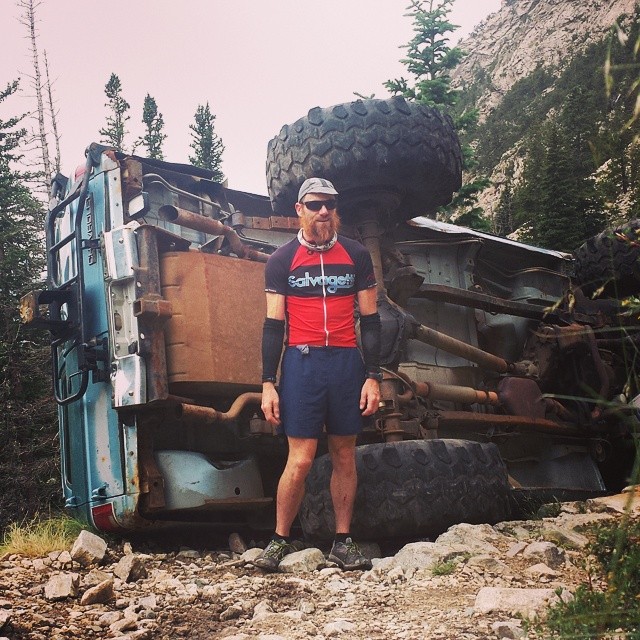
Many will spend the night near Lake Como, to take on the meat of the climb the next day.
The hike from the lake features some difficult and loose terrain, no matter what route you pick. The standard route of Little Bear is presently the West Ridge and Southwest Face (Route Description: 14ers.com, Mountain Project). The route wraps around a few different aspects of the mountain in an attempt to avoid more technical obstacles until it gets to the crux: a loose, narrow Class 4 gully that see quite a but of rockfall, known as the Hourglass.
The Hourglass has a well-earned bad reputation. Other names it goes by: The Bowling Alley; The Shooting Gallery. It’s safe to say that rockfall is a major hazard – if not the biggest hazard, when climbing this route. Rock above is loose, and any rocks dislodged will funnel into the center of the Hourglass, potentially hitting whomever is climbing found in it.
The freeze/thaw cycles of mountain weather make the supply of loose rock never-ending. There’s no way to sanitize this objective danger. Any climbers above can and will kick down loose rocks. You don’t want to be below any climbers who are above you.
Along with lose rock above (rock quality at the crux of the Hourglass is actually relatively solid), the Hourglass seems to always be at least a bit wet, with a trickle of water coming down, straight down the center of the gully itself. Depending on the time of year, and recent precipitation, the gully could be merely wet, or even be a full-on constant stream of water. Oftentimes, the water is frozen and verglass is found throughout the gully. This frozen water makes things very hard to climb making the already-slick slabs impossible to gain footing.
One other curious thing you may find here that’s somewhat rare for Colorado 14ers on their standard route: a fixed rope or two. These ropes are put in mostly by anonymous parties, so the specific reason they’re present is also a mystery. But, a good guess is that they’re there to help ascend and descend the route. They are also problematic.
Below are some big reasons why:
No Formal Fixed Gear Group
What I mean is this: many times, no one knows who puts these ropes up, or even why. No one knows of their experience on setting up this sort of system, no one knows the history of the ropes themselves. The ropes placed could have seen years of heavy use and then, “retired” and “donated” to use in the Hourglass. This is strongly against the ideals of Leave No Trace ethics, and should most likely be frowned upon. Even if the anonymous donor/installer of the ropes had the best of intentions, they could potentially be making a terrain trap for others.
In more popular climbing areas, volunteer stewardship groups are often organized to help with these sorts of matters. Issues like, what are the local ethics to actually be? Is fixed gear something that should be in the area at all? If so, what kind? These groups also work with the local land managers to get permission to put in more permanent fixed gear, like bolted anchors, that will be a safer option for heavy use areas. The stewardship group is also a good place to report of any problems found, as they can help fix them, as well being a trusted and centralized source to get the word out that there are issues.
As far as I understand, there is no such group for the area around Little Bear Peak. Instead, there’s just a lot of questions, and a lot of manky looking, badly beaten up ropes and anchors of dubious quality. This could very well be a trap for whoever is unlucky enough to try to utilizes these ropes in their worst condition. And then what? Who is to blame?
The closest to a stewardship group could be the local Alamosa Search and Rescue group, a non-profit, all-volunteer group of individuals that responds to emergencies in the area. It’s not really their job to maintain the established routes on the mountains the provide SAR services on, but according to their mission reports, they sometimes use the established anchor points to haul loads.
The Ropes Could Be Damaged
Rockfall in the Hourglass can damage these fixed ropes, and over time, cut through the sheath, into the core of the rope itself. Once this is done, the individual strands will unwind, severely impacting the strength of the rope itself. New ropes are incredibly strong for their size and weight. Damaged ropes: not so much.
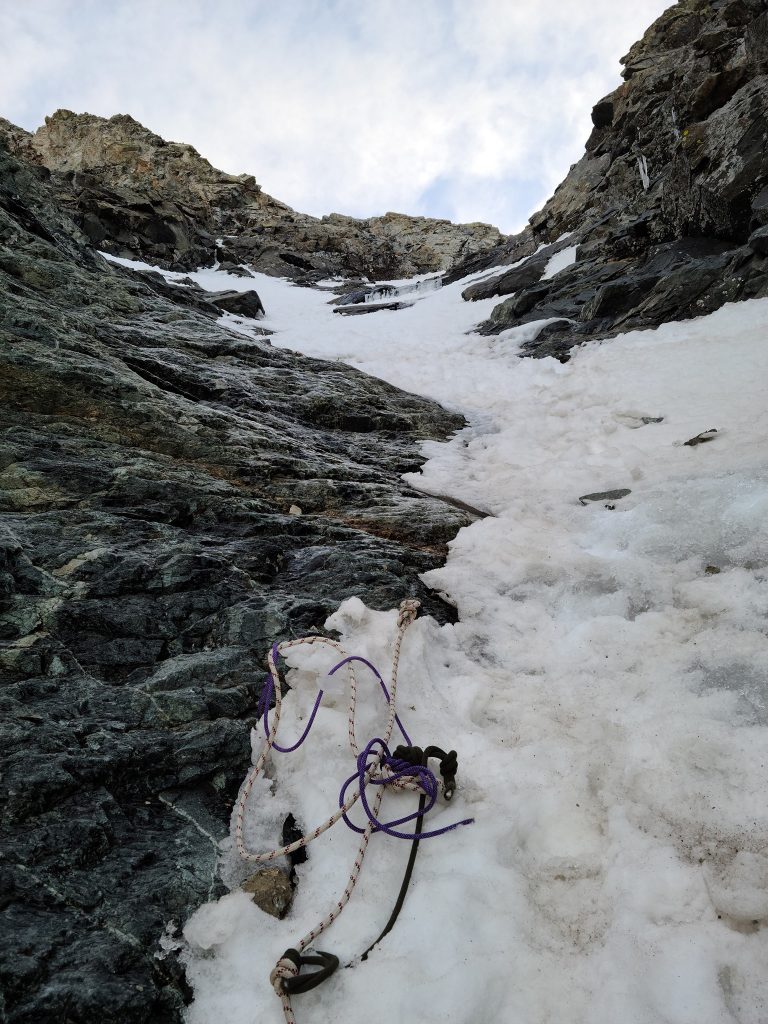
This damage will also make using any sort of ascender or rappel device difficult to utilize, as working through this damage may not be even possible – or at the very least, speed up the damage to the ropes themselves. Many times, these ropes will be tied off to isolate the damage, which helps the strength/integrity of the rope itself, as well as provide a useful handhold of sorts. But, any knots in the rope will also make it difficult to use any mechanical aid to ascend/descend. Even though passing a knot is a basic skill that should be known by a climber, many times those who are climbing up these ropes don’t have those skills.
It’s highly unlikely that someone will tear the rope apart by pulling on it, while using it as an aid to climb up, but it is a remote possibility one should know about, if you are planning to use these ropes to get up the Hourglass.
The Rope’s Anchor Could Be Damaged
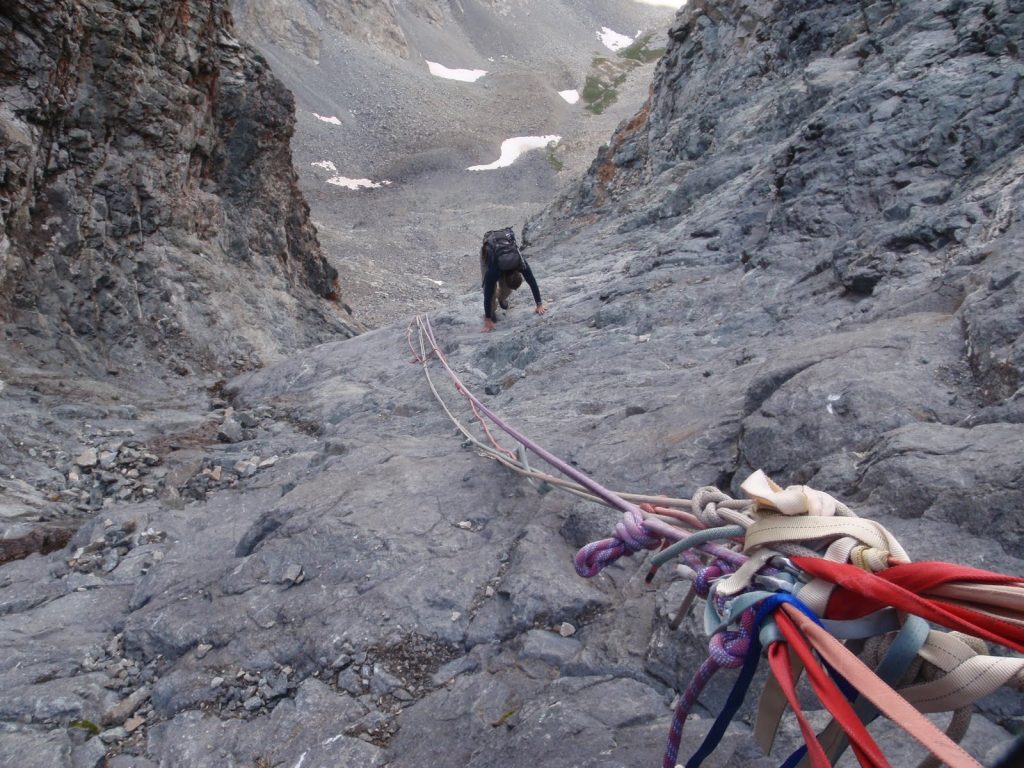
Similar to the problem of damage to the rope, damage to the anchor that ties the rope to the mountain could also be damaged by rockfall, exposure to the elements (storms, UV radiation) or by the work of the greedy teeth of the Marmota flaviventris. This anchor is primarily made of tubular webbing slung around a rock.
It’s very hard to inspect the integrity of the anchor from below. It’s very possible that this anchor is damaged. Even if the rope looks good, what attaches the rope to the mountain is not. Therefore, pulling on the rope will dis-attach it from the rest of the mountain. If you’re the one doing the pulling, you’ll go with it.
It’s another remote possibility, but it’s yet another issue that cannot be reasonably assessed beforehand. Even reports about the integrity of both the rope, and the anchor won’t be valid a day or two after they’re made. Rockfall could have negatively impacted their safety.

The Rope Is Located In the Most Dangerous Part of the Hourglass
This first sounds like an obvious place to have a fixed rope: the crux of the route! But, with a little knowledge of the details of the route itself, this is incorrect.
The ropes are found in the very center of the Hourglass, where the water from above trickles down. As I wrote, this water oftentimes is found frozen, and ice is slippery. This ice can oftentimes encase the rope, making their use difficult.
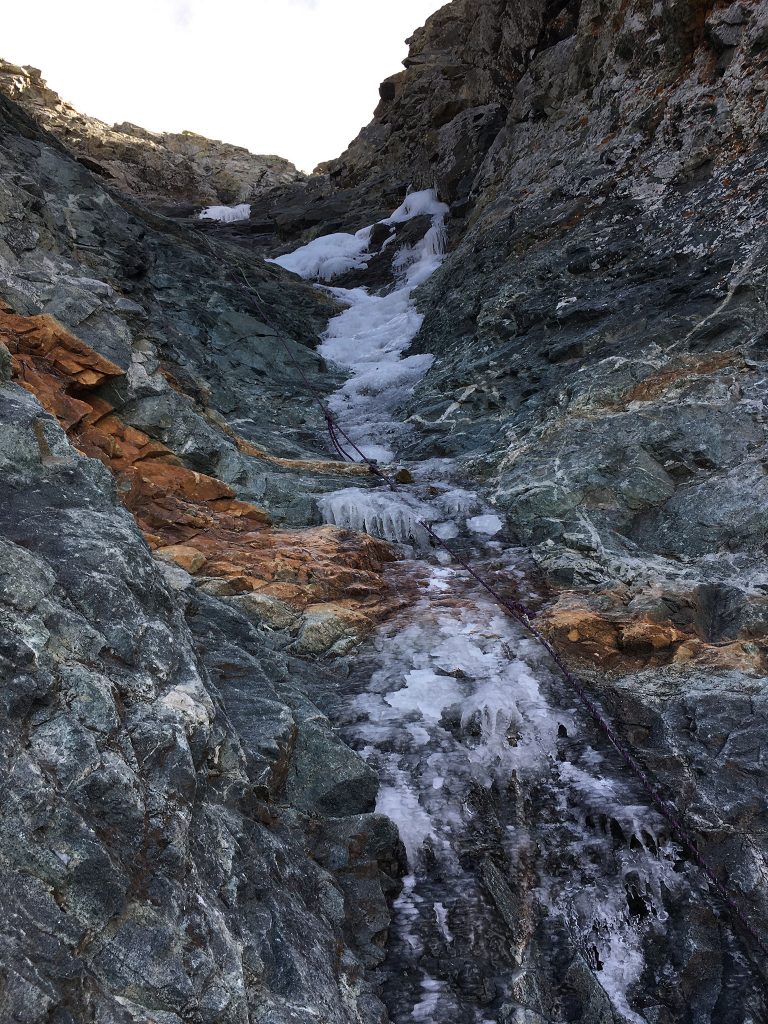
A climber may see the rope and be lured towards them to climb up, even though this area could be wet/slippery when frozen. As I’ve also noted, the very middle of the route is where rockfall is generally funneled down into. Why then, would you want to climb in that exact spot, fixed rope or no?
One option to avoid the very middle of the Hourglass is to scramble up the left side of the gully itself. I’ve scrambled up the Hourglass twice (here’s one report on my time in the area), but never in the middle of the gully itself. Instead, I found better purchase to the left hand side, away from the fixed ropes. The climbing may be slightly harder, but the rock is less wet and slippery.
The Use of Specialized Climbing Gear to Ascend and Descend using the Fixed Ropes
As noted, one could utilize some sort of ascender to help make upward progress up the Hourglass, as well as a rappel device to descend. These are common tools for mountaineers used on fixed ropes. But, what if you’re not a a trained mountaineer?
The 14ers are generally hiked by people who label themselves as hikers, and not mountaineers. The use of mountaineering equipment may not be something they’re as familiar with than they are with other types of gear (hiking boots, cans of beer, etc). It’s a good chance that even if they own an ascender, rappel device, climbing harness etc, they do not know how to properly use them. The Hourglass is probably not a good place to figure this all out.
Many times, those who want to use the fixed rope to help with upwards/downwards travel will do so in somewhat antiquated, or dangerous ways. You can simply “Batman” up the rope, using the rope for your hands (oftentimes pulling up), while walking your feet up. Descent can be done by reversing this technique. This is a pretty terribly method, as nothing is holding you onto the system: you let go, you fall.
Some will merely have the rope available near them while they climb, thinking that they can grab the rope if they start to slip. I would advise against this technique. Once you slip, it’s many times too late to recover.
Descending without the use of a rappel device is also fraught with issues. Although it’s possible to rappel without any device at all via the Dülfersitz method. This isn’t something you should do though, without practice and it is, itself a somewhat outdated method.
Alternative Strategies
I hope I’ve at least help educate you on some of the objective dangers you will find in the Hourglass, and how any fixed ropes you find in there don’t mitigate them, and could perhaps add of them. Is there a better/easier way up the mountain?
There may not be.
Mountains, unfortunately, do not bend to the whims of human wants/needs/desires. The mountain is dangerous.
But here are some ideas:
Climb it in Stable Snow Conditions
Instead of facing the Hourglass in summer conditions, make it a Spring snow climb. The risk of rockfall and loose holds breaking will be less.
The problem with this idea – and it’s a big problem for those looking for an easier solution, is that you’ll need to know how to snow climb, both up and down the mountain (or know how to ski steep couloirs). See the below “Accident in the Hourglass” for accidents happening in snow conditions.
Bring Your Own Ropes and Gear to Make An Anchor
If you know how to make a safe anchor, and you want assistance with getting down the Hourglass, I would suggest this. It’s a big “if” though, right? But, it takes out the big question of the conditions of the rope/anchor that may be there to begin with, and replaces it with a known history of the gear you own.
Still, this doesn’t help with ascending the Hourglass. Using rope/pro may not be advisable, as the nature of the loose rock, together with the wanderings of the rope, could make things more dangerous for those underneath the lead climber. Finding places to put pro in may be nonexistent or problematic. The pitch is going to be a solo for the leader and even if they let a rope down for a weaker follower, the problem with letting forth rockfall aimed at those below is still an issue.
Use an Alternative Route
There are routes other than utilizing the Hourglass to climb Little Bear. None of them will see much better rock quality, but at the very least, there’s a better chance of less people on the route (especially above where rocks can be kicked down), which can minimize the danger of rockfall caused by others. All these routes are more difficult than the Hourglass, and aren’t meant to illustrate an easier way, just an alternative way.
Southwest Ridge
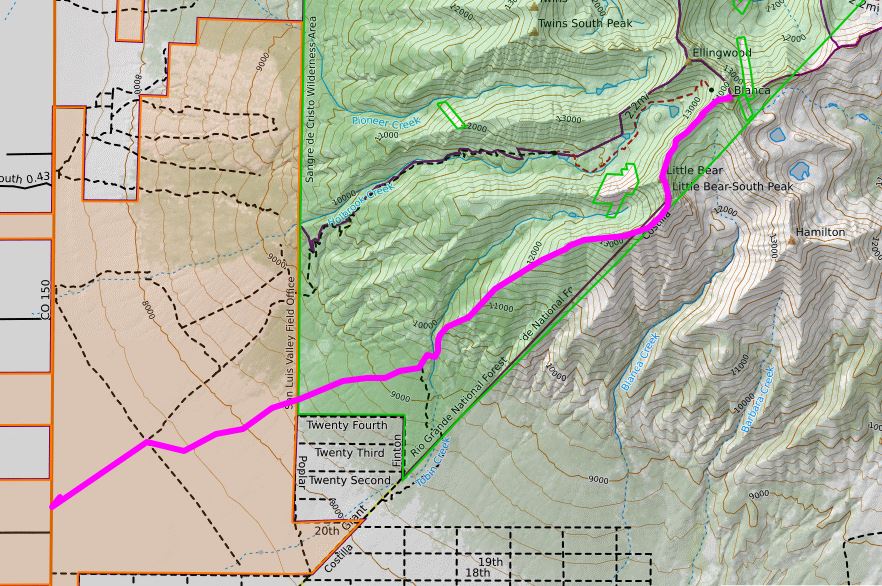
My own trip report contains directions of getting to the base of the southwest ridge, while avoiding much of the bushwhacking, as well as a GPX track to help you out as well – you may have to log into 14ers.com t access it.
West Ridge Direct
- Route Description, Mountain Project
- Trip Report, Alan Arnette, Johnson
This trip report describes a much easier sneak around the Class 5 headwall crux.
I took a trip myself, after riding up:
The technical cruxes will be much harder than the Hourglass Gully, making it only a fair alternative and a no start for those where the Hourglass Gully is already at their limit.
Northwest Face
Accidents in the Hourglass
Through my research, I haven’t found any reports on accidents happening the Hourglass because of a fixed rope or the anchor breaking. I think that’s worth noting, as this specific problem is still a theoretical one. But, this doesn’t mean the fixed gear system in place is safe. I’m also not suggesting you to not use the ropes, only that the decision be made after understanding the risks.
2017 – Stuck on Summit Because of Rockfall
2010 – Kevin Hayne, hold broke(?) in Hourglass
2009 – Avalanche in the Hourglass
2007 – Chris Davenport Party Member Fall on Skis
Additional Accidents on Little Bear
- See the Alamosa SAR Missions page (search for, “Little Bear)
General Accidents Involving Fixed Ropes
Parting Advice
So what do you do, if you want to summit Little Bear?
Evolve Your Mountaineering Skills Beforehand
Little Bear Peak by any route is probably not the greatest first 14er for a beginner. Work up to climbing Little Bear by taking on less technical peaks, or even smaller, lower elevation scrambles. I became well versed with easy scrambling on slabs with trips to Boulder’s Flatirons.
Taking a few trips to a climbing area or gym can help to, but do realize the climbing on Little Bear will be different from climbing at most climbing areas. Mostly, this is because the rock is loose. The problem then is managing climbing on the loose rock, and not ultimately the technical nature of the climbing itself. If the rock in the Hourglass was dry all the time and the rock above it bulletproof, there wouldn’t be much talk about this route’s danger.
What one shouldn’t do is go blindly into Little Bear without assessing the objective dangers and coming to terms with them. Much of mountaineering is taking responsibility for oneself and one’s decisions.
As well as technical climbing skills, it wouldn’t hurt to learning basic mountianeering skills, including using an ascender and rappel device and knowing how to pass a knot while ascending/descending and learning how to set up an anchor with webbing. Simply climbing outside with someone with more experience with you can push you into you to learn these skills. Mentoring is important in climbing. Seek one out.
Mountaineering as an activity ultimately has a large part where objective danger is assessed, and calls are made to either keep going or retreat back. These decisions are rarely made with perfect/complete information. Risk is never removed from the equation. The more information gathered about a scenario, perhaps the better a situation can be assessed. Be safe out there.
Revisions
Thanks for the 14ers.com and Mountain Project communities at large for their feedback on this post. I’ll be happy to continue to edit this post, given feedback. I’ll note any edits to the post, below.
- 10/21/19 – added Caltopo Map/GPX of Southwest Ridge route (since removed)
- 10/20/20 – added a trip report of the West Ridge that describes a sneak around the initial headwall crux, making this route potentially much easier
- 1/28/24 – added my personal trip report on the Southwest Ridge route with an updated GPX.
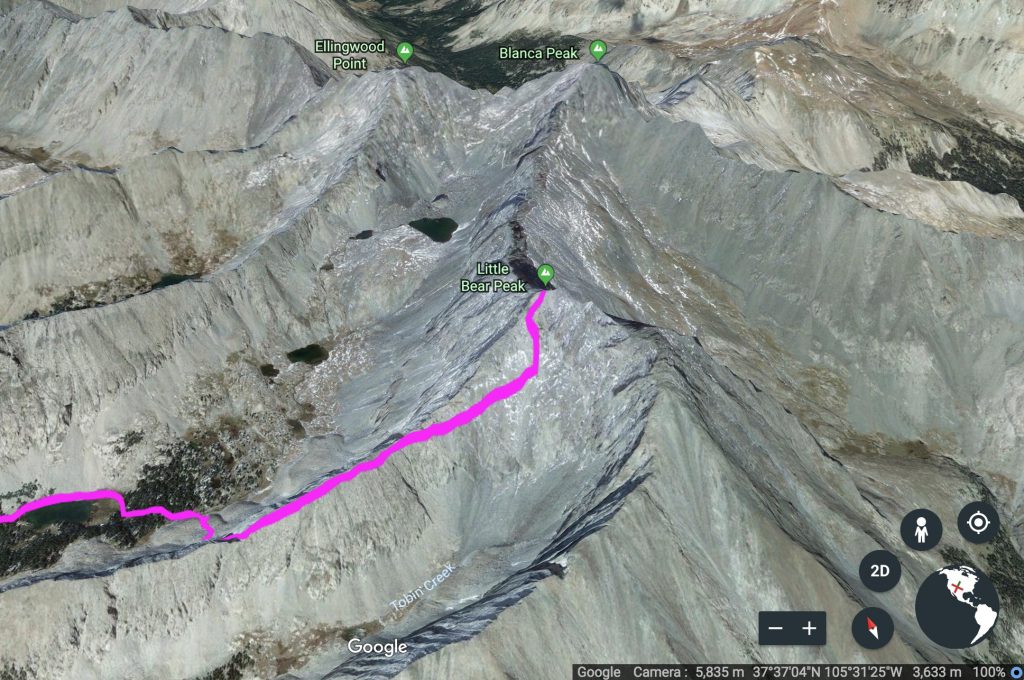
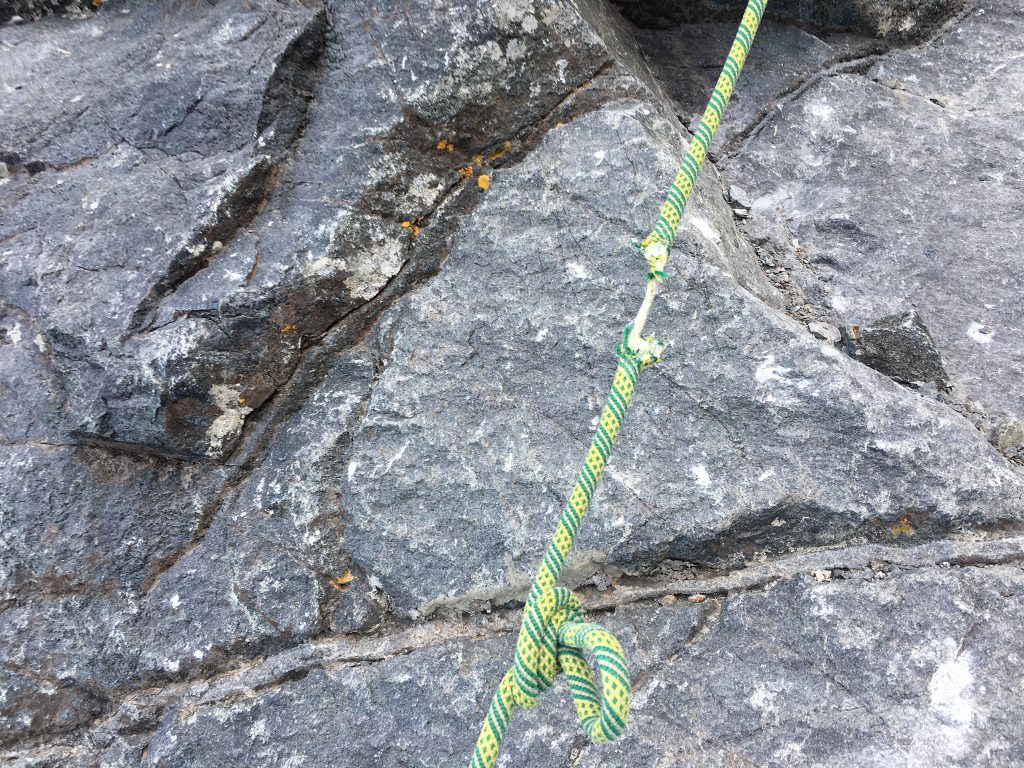



Nice post Justin! I gave the hourglass a shot over 2yrs ago in conditions similar/worse than the foggy pic in your post here. The rock was drenched and we didn’t have the right skills/footwear for the climb, so we turned around 1/3 – 1/2 of the way up the hourglass.
Came back later this year and had LB left as one of my final 14ers (not the last). There had been a new rope put up roughly a week before we were there. It looked bright and shiny new from what we could tell. We didn’t use it at all on the way going up. The plan for myself and my buddy was to do the LB Blanca traverse and not have to deal with descending the hourglass. When we made it to the summit, I decided it was too sketchy for me to do the traverse but my buddy still wanted to do it. So we split up – he went and did the traverse with some randoms from the mtn and I went down the hourglass solo. I thoroughly inspected the rope on the way up and checked the anchors at the top. All looked and felt quite solid, so I decided to trust the rope going down after seeing a group of two rap down the fixed rope just before me. I didn’t bring my harness/belay device with me that day but had the skills to rappel. I decided to more or less “batman”down the rope, which I knew quite well wasn’t the best idea at the time, but felt better than downclimbing the whole thing. It just felt sketchy while doing it and of course I visualized myself just letting go of the rope. The rope was completely saturated 2/3 of the way down from water – I could literally wring water out of the rope! The engineer in me told me this wasn’t good, but I stuck to my plan and carefully and slowly continued down. I was super relieved to be down from the hourglass with good weather. I later went on to finish the 14ers this summer!
On another note, I have done a decent amount of rappelling and know how to properly set up the rappel and back it up. But with the knots in the rope every 6-10ft, how do you negotiate those? I’m not sure what kind of knots those are and if you could tie off into them (clip a biner onto the knot), go off rappel, then move the rap down below the knot, and continue. Do you have any information on how to do this?
The basic jist to passing a knot is to tie a prusik to the rope above, attach that to your belay loop, tie the bottom of the rope to your belay loop as well (as a backup), remove the rappel device, put it back below the knot and remove all the other things that are attaching you to the rope.
Devil is in the details, though, so best to look in a guidebook/ask a guide or something like that. And practice!
[…] Should I Use the Fixed Ropes Found in the Hourglas… […]
[…] Should I Use the Fixed Ropes Found in the Hourglass on Little Bear Peak? […]